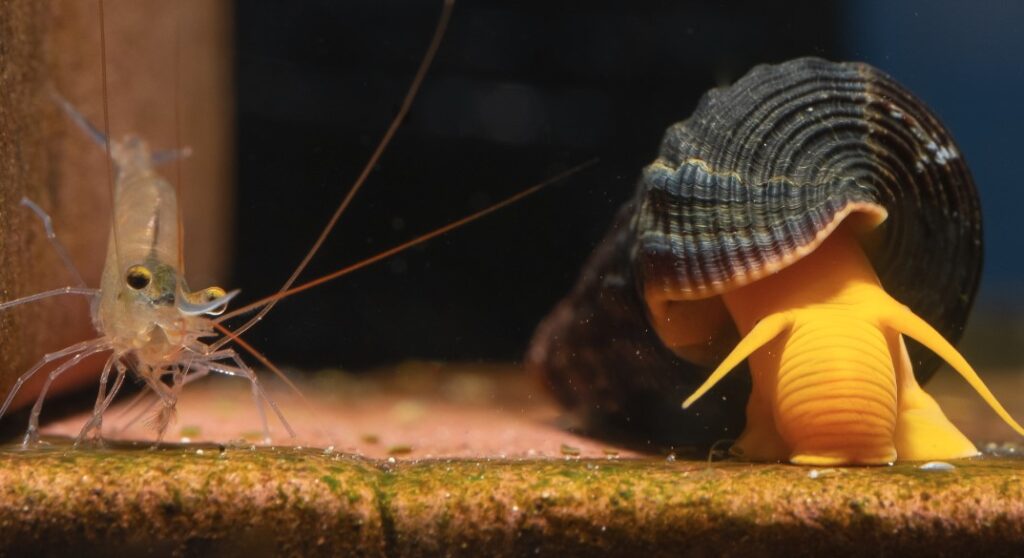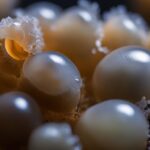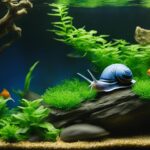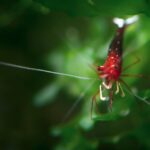Adding snails to a shrimp tank can be a great decision and have many benefits. Snails are excellent cleaners, consuming unwanted algae and dead plant matter. They will also consume uneaten food that remains in the aquarium after a meal, preventing it from breaking down and polluting the water. Not only do they keep the tank clean, but they produce beneficial waste that creates an excellent environment for shrimp growth.
However, there are some drawbacks to adding snails to a shrimp tank. They can carry bacteria and other organisms that may harm or even kill the delicate shrimp population, so supervision of tank inhabitants is essential when introducing any new species.
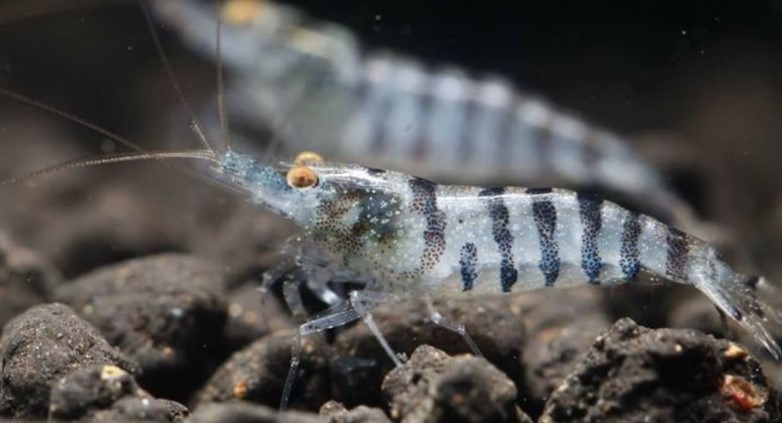
Additionally, some types of snails will eat small shrimp or their eggs. If you’re planning on breeding your colony of shrimp then this could be an issue you need to consider before deciding if snails are suitable for your aquarium setup. In this article, I have prepared a list of best snails for shrimps and will continue to update and refine as I gain new knowledge.
Assassin snail
The Assassin Snail is a truly unique species of aquarium snail. Unlike other snails which peacefully feed off algae, biofilm, and detritus, the assassin snail actively hunts its prey – typically other aquarium snails. As such, it has become popular with aquarium enthusiasts looking to get rid of pest snail infestations in their tanks. It’s important to note that keeping assassin snails in an aquarium with any other ornamental snail may be detrimental to the wellbeing of the latter, particularly if they end up being cannibalized.
Though there is debate as to whether or not Assassin Snails will also target shrimp population in an aquarium, some have been known to attack small baby shrimp amidst a mass feeding frenzy. There is also evidence that suggests that adult shrimp are much less likely to be targeted by Assassin Snails than young ones due to their ability escape a predator’s attention more easily. In either case though, would-be aquarists should take proper precautions and do adequate research on assassin snails before introducing them into their tanks.
Nerite
The Nerite snail is an incredibly popular addition to aquariums and is renowned for its proficiency in clearing algae-ridden tanks quickly. This can be attributed to the snail’s voracious appetite and how it consumes absolutely everything it comes across, often at an alarming rate. Hobbyists find this trait appealing as it not only keeps tanks clean but also helps to improve water quality with their excretions.
Another appealing trait of Nerite snails is the fact that they cannot reproduce in freshwater environments. Unlike other species, young need short periods of brackish water in order to survive, something which does not apply to adult snails. As a result, hobbyists do not have to worry about extra tank inhabitants produced by their pet because any eggs laid will disappear within a few weeks naturally without intervention.
Rabbit snail
The chocolate rabbit snail, otherwise known as Tylomelania perfecta, is best recognized for its unique blackish-brown body and peculiar shell. The shell of wild-caught individuals is covered with a deposit of calcium on the surface, but in an aquarium setting it continues to grow without the deposit. This species requires an aquarium of at least 10 gallons, as it likes more space to swim as well as hide.
This peaceful species will not eat any plants in the aquarium but instead feeds on detritus – such as small insects and recycling organic matter – that settles on the bottom of its habitat. As far as encouraging this species to thrive, ensure to have enough live rocks and hides for them that they can burrow or hide when needed. A sensible diet containing freeze-dried foods should complement their daily scavenging and often protein content should hit around 50%. Regular water changes are also encouraged as with most snails within aquariums. Overall, the chocolate rabbit snail makes a wonderful addition to smaller community tanks if given the necessary care and attention!
Bladder
Bladder snails, commonly misidentified as pond snails, are often found in freshwater environments such as ponds and aquariums. These small snails have a distinctive ‘leopard spot’ design on their shells which twist to the left side of their body. This helps them to be distinguished from their more solid shell designs of pond snails which twist to the right instead. Bladder snails, referred to as Ramshorn (Planorbidae) Snails, are hermaphroditic in nature and two individuals are required for reproduction.
The traditional method of reproduction involves a mating dance between two bladder snails where one snail will rise above the other allowing for sperm exchange through an opening at their basis. The gonads located at the head of the bladder snail then lay eggs inside either a mucous strands or spongy jelly-like bundles that attach to plants or aquarium walls. The reproductive cycle is initiated once fertilization occurs and takes approximately 15 days before new offspring begin to emerge into adulthood.
Malaysian Trumpet
The Malaysian Trumpet Snail, also known as the Red-rimmed Melania Snail, is an ideal addition to any Shrimp tank. This small gastropod is instantly recognizable due to its trumpet shaped shell and relatively small size; typically only reaching just over one inch in length when fully grown. Like many other snails commonly found in aquariums, they specialize in eating soft filamentous algae, especially those loosely attached to a surface.
An important consideration when thinking of getting Malaysian Trumpet Snails is that while they don’t actively feed on live plants inside aquariums, they can still damage them indirectly. This snail’s burrowing behavior means they can knock down and loosen the substrate around the plants roots, leading to instability than could eventually cause the plant to die off. Aside from this minor risk, these snails make a great addition to your tank – not only helping to reduce unsightly algae but also adding some interesting colors and shapes with their vibrant shells.
Ramshorn
Ramshorn snails are a popular addition to Shrimp aquariums due to their stunning aesthetics. Boasting an array of different colors and patterned shells, they come in brown, yellow, blue, pink, red and white as well as leopard-spotted or plain options. Furthermore, their vibrant appearance is particularly attractive to shrimp keepers who love to see them stand out rather than blend into the greenery of their planted tanks.
Additionally, these algae-eating snails make excellent additions to any aquarium due to their prolific breeding habits and ability to consume large amounts of algae quickly. While they seem like they reproduce asexually due to their hermaphroditic nature – meaning they possess both male and female sexual organs – Ramshorn snails need another mate in order for successful breeding. All in all, Ramshorn snails make great inhabitants for any fish tank owners looking for a gardener that can help maintain a clean environment for their residents.
Black devil snail
The black devil snail (Faunus ater) may appear to be a rabbit snail at first, but there are key differences between the two species. Firstly, the black devil snails lack the ridges on their shells present in typical members of the Tylomelania family. Their shells are instead smooth and dark brown, with a lighter brown point at the end. This species is also distinctively black in colour, possibly with a few white dots on its body.
These snails have gained popularity within aquariums due to their active nature. They can often be seen zipping around the aquarium, seeking out new sponges or algae for them to feed upon. Additionally, they do not require any special care and can fit in almost any tank size due to their small size. As such, they make excellent additions to many tanks and offer plenty of lively activity that aquarists enjoy watching daily.
Pond (Avoid)
Pond snails are an unwelcome and annoying pest in many aquariums, as they reproduce quickly. They are able to spread through aquariums by laying dozens of eggs on the leaves of new plants. The eggs can hatch within two to four weeks, with the offspring requiring another six to eight weeks before reaching sexual maturity when they too will start producing eggs, resulting in a rapid cycle that can be difficult to reverse.
Due to their unique characteristics, getting rid of pond snails can be a tricky matter if they’ve already been introduced into an environment. Since they breed via both sexual and asexual means, removing all existing snails from the tank is not enough – one single snail is enough for them to regrow their population given time. Therefore, it’s important to ensure that any plants bought for the aquarium have been properly checked for pests such as these first before bringing them home.
In Conclusion
When it comes to choosing the right snail species for your tank, there are many factors to consider. First, it is important to determine what type of tank environment you wish to create and what type of snails would excel in that environment. For instance, Malaysian Trumpet Snails are excellent detritivores, thriving on shrimp waste and decaying plant matter. Assassin snails can help keep a tank clean by preying upon smaller creatures such as pest snails and even small fish. On the other hand, Nerite Snails are more resilient towards harsh water conditions and can scavenge small pieces of algae or diatoms from surfaces within the tank.
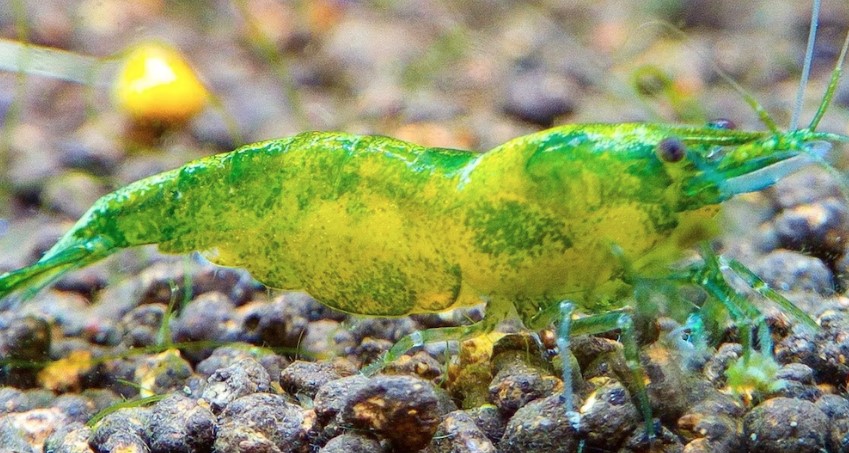
It is also important to consider the presence of other inhabitants when introducing snails into a tank. If you have shrimp in your tank, be sure not to introduce any predatory snails; Tiger Shrimp, Yellow Fire Red Cherry Shrimps should all be safe from potential predation. Consider carefully when making your choice of snails and make sure they meet the requirements of your tank
I hope you enjoyed this article covering best snails for shrimps tank, I have plenty more facts in my shrimp section if you need further advice.

